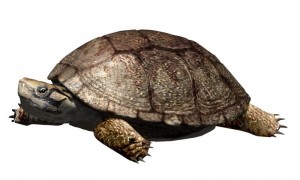Researchers* have recently published in the online edition of the journalCretaceous Research the discovery and description of a turtle from the end of the age of dinosaurs.They have named this new species as Polysternon isonae, in recognition of the municipality of Isona I Conca Dellà (Catalonia, Spain), where the fossil remains of the specimen type have been found.
The abundance of dinosaur fossils that lived between 65 and 70 million years ago in the area currently occupied by the Pyrenees It is well known. In this range we find dozens of sites with bones, footprints and eggs of the last dinosaurs that inhabited our planet, the Tremp basin being one of the areas with the highest concentration of fossils.
However, lesser-known are the other organisms that completed the ecosystems at the end of the Cretaceous period, consisting of other vertebrates, invertebrates, plants, fungi, etc. A common feature of these ecosystems were turtles. In the Pyrenean sites, their fossils are relatively abundant and, in general, consist of isolated shell plates or small sets of plates that can help us get a general idea of the morphology and size of the animal. Instead, the entire shell finding is rare and even more exceptional are the findings where parts of the skeleton are preserved within the shell.
In recent years, in the municipality of Isona i Conca Dellà (Catalonia) numerous discoveries of turtle remains have been made, spread over several sites. One of these sites, that of Barranc de Torrebilles, has given fairly complete remains that allowed describing a new species: Polysternon isonae. The remains found consist of dozens of isolated plates derived from the fragmentation of shells through their sutures, and what is more important: a fragment of the ventral side of a shell and an almost entire shell, which without being totally complete, show morphological features of great interest to paleontologists and have allowed to describe this new species. These remains were recovered during two excavation campaigns conducted during the summers of 2008 and 2009.
So far, two species of the genus Polysternon were known : P. provinciale and P. Atlanticum (plus a possible third P. Mechinorum), distributed only in what is know the south of France and the Iberian Peninsula. They were animals adapted to swimming and living in fresh waters, in the deeper areas of rivers and lakes. Specifically, the shell of the new species P. isonae was oval, measuring about 50 centimeters long and 40 wide. The remains were found preserved in a very hard sandstone strata now exposed in the Barranc de Torrebilles. Just over 65 million years ago, when the animal died, this was not a lithified sandstone and consisted of fine sand that was washed away by river streams and that was deposited, along with the remains of other turtles of the Barranc de Torrebilles, at the bottom of one of these rivers.
Unlike other kinds of turtles, it seems that Polysternon did not survive the end of Cretaceous and went extinct with the dinosaurs. The close proximity of the site Barranc de Torrebilles to the geological level that marks the end of the Cretaceous extinction, indicates that Polysternon isonae was possibly one of the last species of the genus Polysternon.



 February 28th, 2012
February 28th, 2012  riffin
riffin 
 Posted in
Posted in 